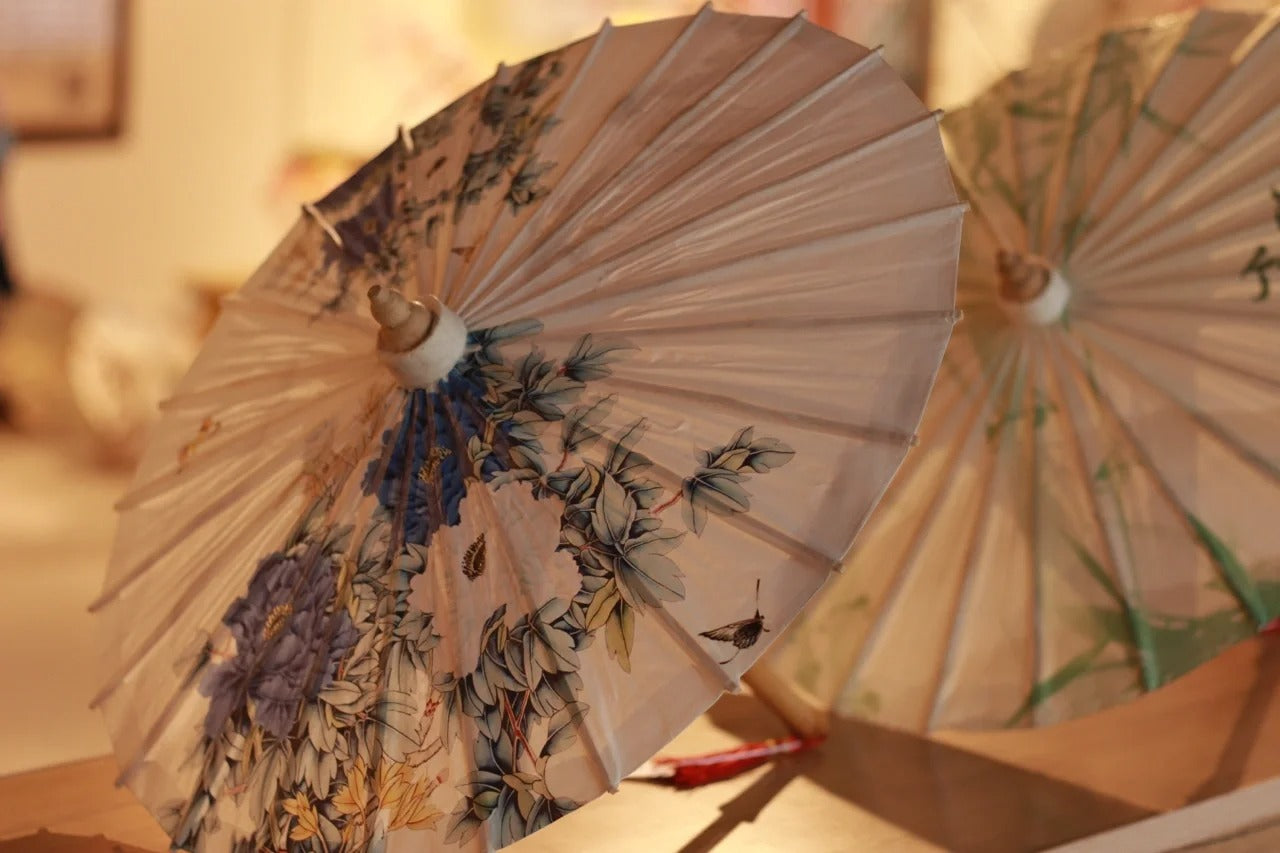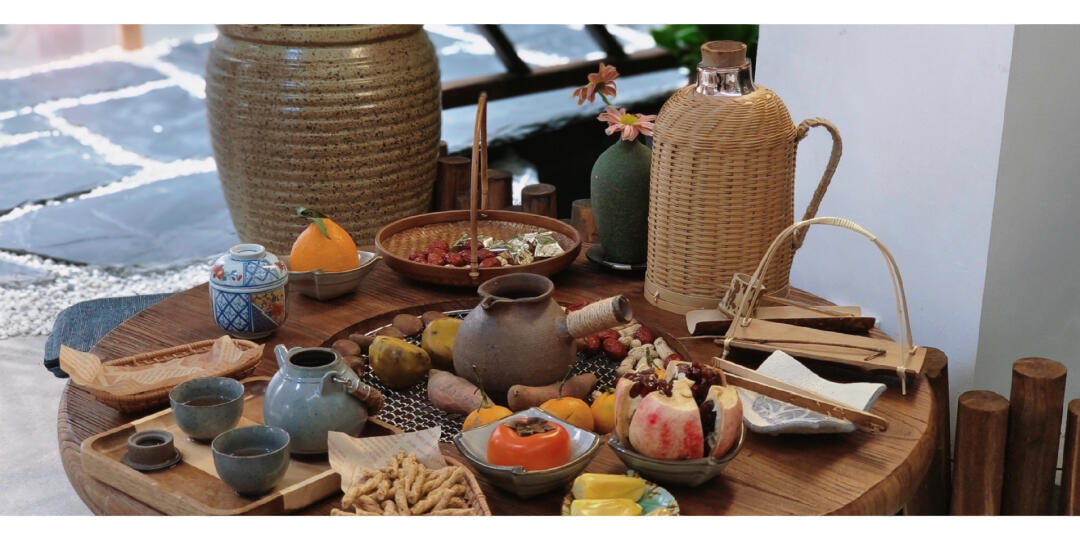The history of oil-paper umbrellas
The oil paper umbrella has a history of over 2,000 years, originating during the Han Dynasty in China. Initially made for protection against rain and sun, it became a cultural symbol. Using bamboo and oiled paper, these umbrellas were waterproofed with tung oil. They hold significant cultural value, often seen in traditional weddings, festivals, and ceremonies.

Artisans began painting intricate designs on the umbrellas, turning them into artworks. Each Chinese region developed unique styles, and the umbrella's beauty and utility spread to other Asian countries, such as Japan and Korea.

Today, there is a renewed interest in preserving this traditional craft, making oil paper umbrellas a cherished symbol of Chinese heritage and artistry.
How to make an oil paper umbrella
Shaved bamboo bark
The first step in making an umbrella rib is to take a suitable bamboo section and then scrape off the green skin. In addition to making bamboo umbrellas, when making bamboo chairs or bamboo stools in my hometown, I have to do this first.

Split umbrella ribs
The large bamboo tube is split into small pieces, and the small pieces are further split into long strips.

Sharpen umbrella ribs
One end of the split single rib still needs to be tapered. Let’s call this the top of the rib.

Umbrella ribs slotted
You also need to cut a slot and drill a hole on the long rib of the umbrella near the top 1/4, which will be used to connect to the short rib of the umbrella~

Umbrella rib drilling
Then use a very handy drilling tool to apply force through rotation to drill small holes on the top of each umbrella rib, and then thread the thread to connect the umbrella head.

Umbrella rib threading umbrella head
The structure of the upper umbrella head and lower umbrella holder are similar. They are both used to carry and connect the umbrella ribs. They are usually chiseled out of a single piece of solid wood. In addition to drilling holes on the top of the umbrella ribs, the umbrella head also needs to be drilled, and then threaded together to connect them as shown in the picture below, and then the ribs are embedded one by one...

After the upper umbrella head and umbrella long ribs are connected, the lower umbrella support and umbrella short ribs are made and threaded in the same process.

Long bone threading short bone
There are four parts of the opening and closing structure: the umbrella head is connected to the long ribs of the umbrella, the umbrella holder is connected to the short ribs, and naturally the long ribs and short ribs are connected. This is the purpose of notching the grooves on the long ribs of the umbrella!

Then there are several more rounds of threading to connect the long ribs to the short ribs...

Open and close test
Although the umbrella pole has not been inserted yet, the opening and closing structure can be tested to see if the entire umbrella opening and closing movement is smooth~

Net umbrella shaping
There is no fixed opening and closing path between the ribs, so the entire umbrella frame needs to be wired and shaped. The distance tool in the hand of the umbrella maker in the picture below is called a "zhezi". Each click is a fixed distance between the umbrella ribs.

Winding umbrella
Some steps of crossing the umbrella are done at this time, and some are done after the entire umbrella is made.

Make a bamboo jumper
If I were asked to say what is the most amazing structure of the entire bamboo oil-paper umbrella, I would definitely say it is the "bamboo jumper" that is made entirely of bamboo and is used to lock the throat at the opening and closing!

Umbrella paper
After brushing the paste on the umbrella ribs, you can stick the rice paper layer by layer to the inside and outside of the umbrella ribs.

In addition to pasting the upper umbrella surface, of course you also have to paste the lower umbrella surface and the edges. Some traditional crafts also use persimmon water as natural glue, which is the sticky juice obtained by pressing persimmons...
Umbrella drying process
The umbrella surface has only been glued on and has not yet been painted with tung oil. Now it needs to be dried in the sun.

Preliminary closing of umbrella
Before painting the umbrella surface, the umbrella maker also needs to preliminarily close and fold the newly dried paper umbrella with his hands, and tidy up the umbrella surface.

Hand-painted umbrella cover
Now we invite our highly skilled hand-painters to paint freely on the umbrella surface. The pigments here are all mixed with tung oil. This treatment can prevent smearing and color the paper surface better. After all, our umbrellas are for rainy days. Holding an oil-paper umbrella, we wander alone in the long, long and lonely rain alley...

Creases
In order to follow the opening and closing of the paper umbrella in the future, now the entire umbrella is gathered and tightened, and then the tools are used to adjust the gaps in each gathering mark.

Install umbrella handle
It’s time to install an umbrella handle on the bamboo pole of the oil-paper umbrella. Don’t forget to paint the umbrella handle with anti-corrosion varnish.

Cloth head
When we put the umbrella down casually, the umbrella head comes into contact with the ground more frequently, which is a part that is easier to wear. Wrap the oil-paper umbrella with cloth ends. One is because cloth is less prone to wear and tear than paper, and the other is to drain rainwater when it rains. The last one is beautiful~

Open umbrella
Pusa~ The oil paper umbrella you wanted is now online!






